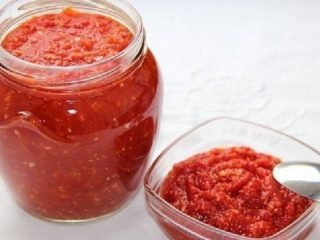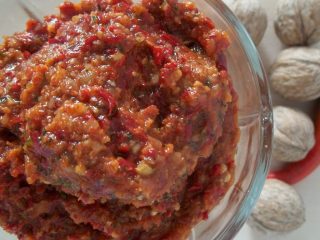Content
At the end of the summer season, caring housewives are wondering how to prepare this or that preparation for the winter. Particularly in demand during this period are adjika recipes. Often, among the variety of options, cooks are looking for instructions on how to prepare spicy adjika. without cooking. Especially for such lovers of fresh and spicy food, we will try to describe in detail the best recipes for making excellent sauce.
Simple recipes for delicious adjika
Fresh adjika has three main and very important advantages:
- simplicity and high speed of preparation;
- excellent taste that can complement meat, fish, vegetables and large dishes;
- a huge amount of vitamins in the composition, which are successfully stored all winter, bringing benefits to humans.
Having decided to cook spicy adjika without cooking, it is important to choose a good recipe and bring it to life with precision. After all, making even minor, at first glance, adjustments can lead to the fact that a fresh product will spoil very quickly, even in the conditions of a refrigeration chamber.
Fresh adjika from tomato according to the classic recipe
The recipe below allows you to prepare a large amount of hot sauce for the winter.The proportions of the ingredients are arranged in such a way that the result of cooking is a fragrant mixture of vegetables and spices in an amount of 6-7 liters. If this volume is too large for the family, then the amount of ingredients can be proportionally reduced.
To prepare spicy and aromatic, fresh adjika you will need:
- Tomatoes. Despite the fact that the vegetables will be chopped, their quality needs to be given special attention. There should be no putrefactive spots or black spots on the surface of the tomatoes. If defects are detected, damaged areas from the surface of the vegetable must be removed. The quantity of tomatoes for one recipe is 6 kg.
- Bell peppers. It is preferable to use red vegetables so that the color of the sauce is uniform. Before cooking, it is necessary to cut off the stem of the peppers and clean the inner chamber of the seeds. The weight of a clean pepper should be 2 kg.
- Garlic should be used in an amount of 600 g. It is important to remember that the most aromatic garlic can only be found in the garden. Vegetables from the store counter may taste different. It is recommended to use it in slightly larger quantities.
- Chili peppers will make adjika especially spicy. It is recommended to add 8 peppers to one serving of sauce. The amount of the ingredient can be increased if desired, since chili is an excellent preservative and promotes long-term storage of fresh products.
- Add sugar and salt 2 and 6 tbsp. l. respectively.
- Use table vinegar in the amount of 10 tbsp. l.
The rules for carefully selecting and preparing vegetables apply not only to the recipe proposed below, but also to other options for preparing fresh adjika.The thing is that even the slightest fungi of rot, fermentation or mold can spoil a product that has not undergone heat treatment.
The process of preparing adjika is quite simple and consists of the following steps:
- Peel, wash and dry vegetables.
- Grind the tomatoes and bell peppers in a meat grinder.
- Hot chili pepper and mince the garlic twice.
- Mix all vegetable ingredients, add salt, vinegar, sugar.
- Leave the mixture at room temperature for 2-3 hours.
- Place adjika into sterilized jars and close with tight lids.
If fleshy tomatoes are used in the preparation of adjika, the consistency of the sauce will be quite thick. Tomatoes with a high content of free juice can be “dried” before chopping by cutting them into small pieces and placing them in a colander to drain the juice.
You can evaluate the taste of the resulting adjika literally immediately after preparation. The spicy-sweet sauce will complement any dish and make even an ordinary piece of bread surprisingly tasty.
Fresh adjika with carrots and mustard
Carrots are rarely included in fresh adjika. This is due to the fact that without heat treatment the vegetable has a fairly dense structure and literally crunches in the mouth. However, a small amount of carrots may be appropriate in a fresh sauce prepared according to a special recipe. So, below are recommendations on how to prepare fresh, tasty and very spicy adjika with carrots for the winter.
To prepare spicy adjika with carrots, you will need 500 g of ripe tomatoes, 300 g of sweet and sour apples (you can take apples of the famous variety “Antonovka"), bell peppers, preferably red, 500 g, 4-5 pods of hot pepper. Carrots, parsley root and garlic are used in equal parts for one recipe, 300 g of each component. The uniqueness of the recipe is the use of mustard. This product will give adjika a unique taste and aroma. The amount of mustard should be 100 g. The recipe also includes 2 tbsp tomato paste. l., salt to taste, half a glass of vinegar 6%.
Having collected all the ingredients on the table, delicious adjika can be prepared in literally 30-40 minutes. To do this you need to do the following:
- Peel the carrots, wash them, cut into small pieces. If desired, they can be blanched in boiling water for 5 minutes. This will soften the vegetable. Place the blanched carrot pieces in a colander to drain excess water.
- Wash bell and hot peppers, remove the stem from their surface, and remove the grains from the inside.
- Wash the tomatoes, if desired, remove the skin from their surface, cut out the roughened place where the stalk is attached.
- Remove the skin from the surface of the apples and cut the fruit into quarters.
- Grind the prepared vegetables and fruits with a blender or meat grinder until a homogeneous mixture is obtained.
- After thoroughly mixing, add tomato paste, mustard and all remaining ingredients to the mixture of crushed products.
- Leave the resulting adjika for several hours at room temperature, then put it into sterilized jars and preserve.
Immediately after cooking, it may seem that the taste of vinegar in adjika is too strong, but over time the acid will partially evaporate, apples and carrots will add sweetness to the sauce. That is why the final result and taste can be assessed approximately a week after preparation.
Adjika from tomato paste with celery
Using tomato paste allows you to get a thick and very tasty adjika. In the proposed recipe, tomato paste is successfully combined with celery, herbs and other ingredients. You can prepare fresh sauce for the winter quite quickly. So, skillful hands will cope with the task in no more than half an hour.
In order to prepare fresh adjika you need 3 liters of tomato paste, 25 pcs. medium-sized bell peppers, 10-12 hot chili peppers, 18 heads of garlic. Parsley, dill and celery will add a special aroma to the sauce. Each type of greenery should be taken in the amount of 200 g. Salt is added to adjika in the amount of 2 tbsp. l. with a slide, sugar in the amount of 12 tbsp. l. The composition also includes vinegar essence 9 tbsp. l.
Preparing adjika will be quite simple if you familiarize yourself with the following points:
- Peel the garlic, remove the stem and internal grains from hot and bell peppers.
- Mince the garlic, peppers and herbs several times through a meat grinder.
- Combine the resulting mixture with tomato paste, sugar, salt and vinegar.
- Let the adjika steep for several hours and then pour into clean, sterilized jars.
Fresh adjika prepared according to the proposed recipe should be stored in a dark and cool place. Such storage conditions are typical for a cellar or refrigerator.You can eat the product literally immediately after preparation.
Spicy adjika with horseradish
The recipe proposed below can be found in many cookery books under various names: “Ogonyok”, “Hrenovina” and others. The main difference between this recipe and other options for preparing adjika is the use of ground black pepper, horseradish and other spicy and hot ingredients. As a result of a competent combination of a certain set of products, it will be possible to obtain a spicy, tart and very aromatic seasoning for meat and fish dishes, soups, and salads.
To prepare aromatic, spicy adjika for the winter without cooking, you will need 2 kg of tomatoes. The tomatoes will be the basis of the sauce. No additional mild-tasting ingredients (bell peppers, carrots or apples) are used in the recipe. The spicy taste and pungency of adjika comes from 3 chili peppers, 3 heads of garlic, 3 tbsp. l. black pepper (ground), 150 g horseradish (root) and salt, in the amount of 3-4 tablespoons. This “explosive” mixture allows you to fully satisfy the needs of spicy food lovers.
Preparing adjika takes little time and does not require any special skills from the cook. So, the whole process can be described in several simple steps:
- Wash the tomatoes, cut into pieces and lightly strain the juice. This will allow you to prepare a thicker adjika. To obtain a delicate consistency, it is recommended to additionally remove the skin from the tomatoes.
- Grind the chili pepper, horseradish root and garlic in a meat grinder several times to obtain a homogeneous mixture.
- Grind the tomatoes in a meat grinder and mix the resulting puree with garlic and pepper.
- Add ground pepper and salt to the resulting vegetable preparation.
- After dissolving the salt, place the adjika into clean jars and close the lid tightly.
The proposed recipe is popular among housewives, since such adjika can be quickly and easily prepared from available products, and then stored for a long time in the refrigerator. If necessary, a spoonful of the spicy mixture can always be a good seasoning for soup or a sauce for meat, fish, or an addition to vegetables and large dishes.
Conclusion
Of course, it is impossible to list all the recipes for spicy adjika without cooking. The article offers the best and most frequently used cooking options, which are time-tested and have found a lot of admirers. In addition to the suggested recipes, it is also worth paying attention to another cooking option, which is described in detail in the video:
A visual guide will allow even a novice housewife to successfully cope with the culinary task and surprise her family with tasty, fresh and very healthy adjika, which will always be on the table.


















